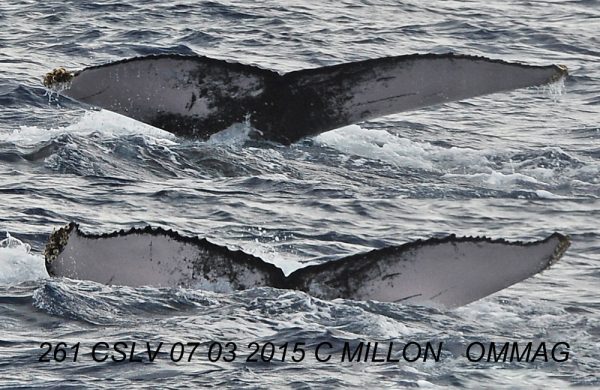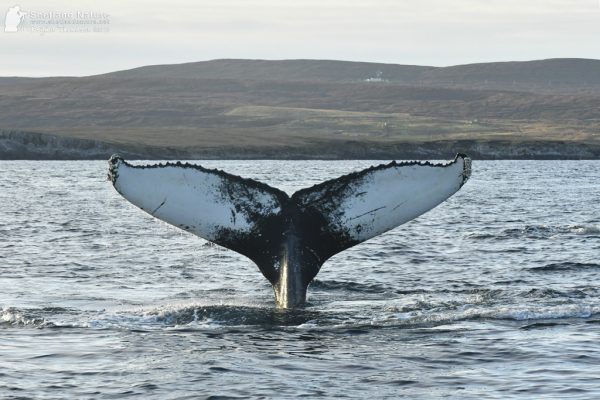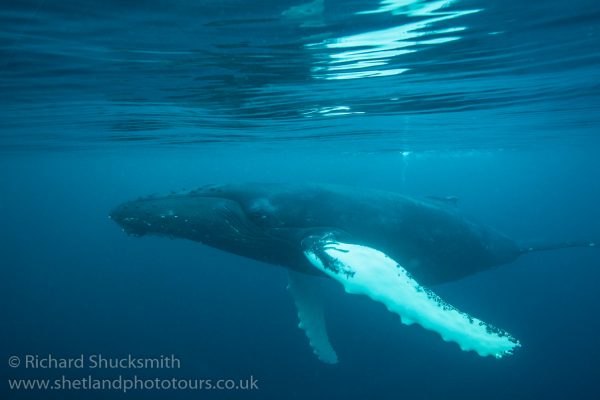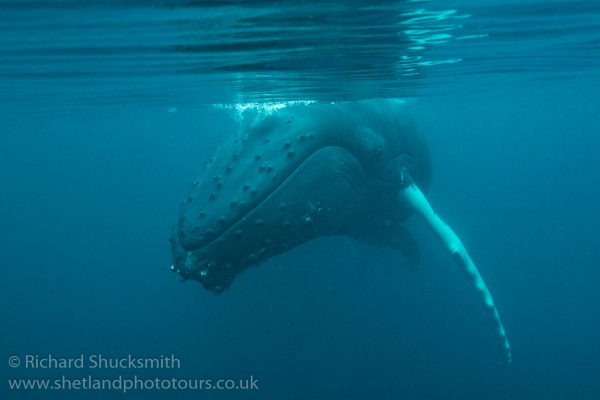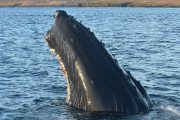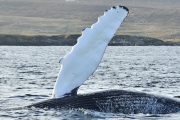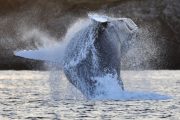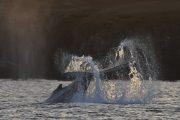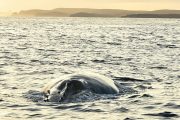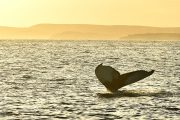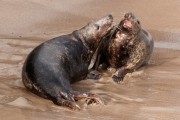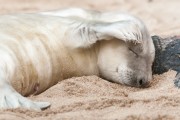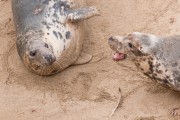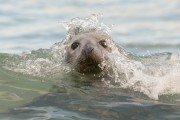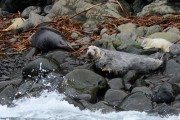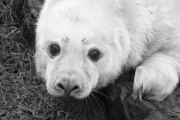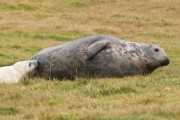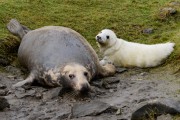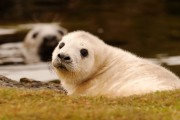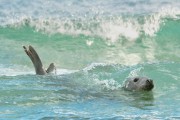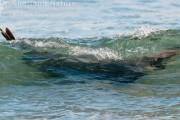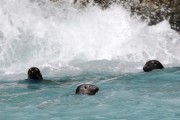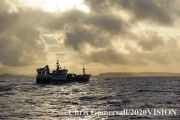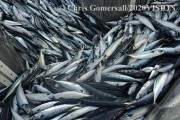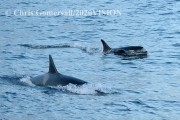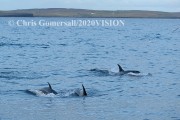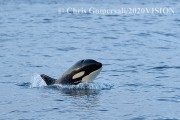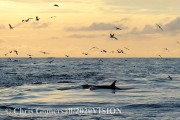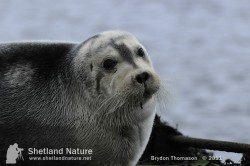Archive for the ‘Sea Mammals in Shetland’ Category:
A Humpback ID match UK first: Caribbean/Shetland Islands
Posted by Brydon Thomason on Wednesday 15th February 2017 | Sea Mammals in Shetland
I find it quite incredible to write about yet another chapter in the story of Humpback Whales that spent five weeks this winter between Yell, Fetlar and Unst. Each part of the story to unfold has certainly been worth sharing and now, none more so than this one. It is thanks to a very exciting, encouraging and gratifying international collaboration we discovered that for the first time ever a Humpback Whale has been recorded in British waters from the breeding grounds off Guadeloupe, in the southeast Caribbean!
Back in early December I was able to capture several close-up images of at least two of the five whales tale flukes. In addition to the thrill in nailing images of Humpbacks I would never before have thought possible in Shetland, I could see that potentially for the first time ever in Shetland or even UK waters, good enough images of the detail needed for ID work may be possible. As many who have seen or worked on Humpbacks in UK waters, getting good close up and detailed images of tail flukes are rarely possible. I put some ‘feelers out’ by email and via social media with a couple of images, asking for any help and also to The North Norwegian Humpback Whale Catalogue (NNHWC).
Far from being anything near an expert on Humpback Whales I hoped that the Norwegian wintering populations might make most sense however the NNHWC, as helpful as they were did not find a match. It was on Twitter however that Dan Lettice recommended Pádraig Whooley of The Irish Whale and Dolphin Group (http://www.iwdg.ie/). This was where it really began to pick up pace. Pádraig was totally fantastic, a wealth of knowledge about Humpbacks and their movements, especially through their work off Ireland but also his tireless enthusiasm and passion. Straight away he took on to do what he could with their humpback whale photo ID database but more so recommended I send the images to The North Atlantic Humpback Whale Catalogue (NAHWC) at the College of the Atlantic, Bar Harbor, Maine, USA. (http://www.coa.edu/allied-whale/research/)
As had been the case from Ireland and Norway, they were thrilled to receive images and offer help. From the offset I had cc’d each organisation into the email sent to Maine and so the collaboration began. Each and every one of us was as amazed as the other when word came back- they had found a match! This same whale had been photographed on the breeding grounds off Guadeloupe in the Caribbean!! The first ever match from British waters to their breeding grounds!
It was Frederick Wenzel (NAHWC) who picked out the match from their database, the largest of its kind with >9,000 individual tail fluke images (spanning from 1976 to 2016) maintained at Allied Whale; by Judy Allen, Peter Stevick and Tom Fernald.
Laurent Bouveret, who directs the OMMAG Observatoire des Mammifères Marins de l’Archipel Guadeloupéen (OMMAG) (http://ommag.info/) project, which includes hundreds of photos of whales from the eastern Caribbean was thrilled with the news; “Fred and Tom you made my day!! In attachment, our picture taken by Whale watcher Cedric Millon from Guadeloupe Evasion Découverte company, the 7th March 2015, leeward side of Guadeloupe Main Island N 16.2161111 W -61.814166, an adult accompanied with another adult”.
How amazing was that for the same whale to be photographed here in Shetland approximately 4,500 miles away! Interestingly on the day of the encounter, this whale was again accompanied with another adult. Although I did nail ID images of its tail flukes however, there have been no further matches. I couldn’t help but wonder if it could be the same two whales still together.
Padraig’s response and his enthusiastic ‘sportingly competitive’ banter especially amused me; “Crikey… how’s that for beginners luck? We’ve been sending Irish humpbacks for years to the NAHWC catalogue without a single match to a breeding ground, and our friends in Shetland manage a match on their 1st share- Wonderful news!”
“This really sets the cat among the pigeons as we’ve had something of a working hypothesis that our Irish humpbacks are more likely to be from the Cape Verdes on this side of the Atlantic. This is a great result and an important contribution to our understanding of these iconic animals”
Although this is the first ever match from UK or Ireland to a breeding ground there has been many photographic matches from Norwegian waters to the Cape Verde Islands as well as the Caribbean. At this time, the Irish humpback collection has produced matches to the Netherlands, Gibraltar, Iceland and Norway.
Having had the sharp eyes to pick out the match Frederick Wenzel has conducted photo-ID matching of right whale, blue whales and humpbacks for many years. “I voluntarily curate the Cape Verde Island humpback catalogue, and work closely with Fredrik, Laurent, Padraig and many others in this international collaboration … Wenzel currently works for the US govt. at NOAA, National Marine Fisheries Service, Northeast Fisheries Science Center, Woods Hole, Massachusetts, USA on large whales, pinnipeds, foraging ecology and bycatch for small cetaceans and seals.
“At times, I can say I have a photographic memory…I recognize flukes. I have seen before…however, in the same breath…I may not remember someone’s name, but I recognize their face”.
In Norway (NNHWC), Fredrik Broms has produced some interesting matches to Iceland, Cape Verde Islands, Guadeloupe and the Dominican Republic. The team at NNHWC are currently working on a very interesting project having satellite-tagged ten humpbacks off Tromsø this winter. You can find out more about this at https://whaletracking.uit.no/.
This unprecedented ID match in itself is of course significant and will hopefully perhaps help to grow our understanding of these wonderful creatures and their movements. For me personally I was just lucky to be in the right place at the right time to get a shot good enough images to assess by the researchers and organisations. It is however their ongoing commitment, research and perhaps above all collaboration that makes discoveries such as these possible.
Something that I noticed straight away when I started to look to where to send images was that there isn’t actually a UK catalogue/project. Granted of course there are some great organisations doing fantastic and very important work such as Sea Watch Foundation but no one is yet to set up an actual ID catalogue/database. This appears to be something that the international projects already working together are aware of and can see the need for.
But of course a reason for this may well be that as mentioned above there are very few good enough images that exist in British waters but as Pádraig pointed out, it only takes one image to start and already we have a result; “It will be great If interested groups could come together to document these animals in Scottish waters and a good way to pull this together is by setting up a Scottish humpback whale catalogue”.
With the quality of camera equipment used by so many people now and indeed social media there has never been a better time for this to start and as I found out with images from our encounters, anyone can contribute and make a difference. With such a fantastic and growing success story for Humpback Whales it seems quite likely we will have opportunity to enjoy them and hopefully help further our understanding of their movements.
A huge thank you to the following individuals and organisations for their help and collaboration; Pádraig Whooley of The Irish Whale and Dolphin Group; Frederik Wenzel, Thomas Fernald, Judy Allen and Peter Stevick of the NAHWC; Laurent Bouveret of the OMMAG; Frederick Broms of NNHWC and Cedric Millon from Guadeloupe Evasion Découverte company OMMAG https://www.facebook.com/ommag971/ and http://www.guadeloupeevasiondecouverte.com/
View previous posts:
Permalink
Underwater Humpback Whales in Shetland: a UK photography first
Posted by Brydon Thomason on Friday 6th January 2017 | Sea Mammals in Shetland
In early December 2016 I had enjoyed a truly unforgettable encounter with the Humpback Whales off Yell, as had many others fortunate enough to see them over their four week stay. Stunned to have enjoyed such unprecedented photographic opportunities in Shetland waters, I couldn’t help myself from sharing the experience via some ‘light hearted banter’ with good friend and colleague Richard Shucksmith who was away working on Scottish Mainland and being honest, I knew would be gutted to be missing out!
Knowing the wider potential and photographic opportunity to be made the most of, (especially with Richard’s expertise), capturing imagery of their underwater world was our number one priority on his return home. With a perfect forecast on 16/12/16 of clear skies and mirror calm seas all other projects were set aside and thankfully Peter Hunter was also available to take us out on his boat.
Setting out that beautiful frosty morning with the sun rising to light up a cloudless blue sky we were buzzing with hope, excitement and even a little angst as the reality was that although the whales had been reported daily, they could leave any day. We were also well aware that even if they were still there but did not perform our plans may amount to little more than memories of what we could have done.
Our good fortune had extended beyond the weather window- the whales were still there. We were intrigued to notice straight away however that only two of the five we had spent time with earlier in the month remained. These were two smaller individuals, which we thought to be sub adults, clearly smaller than the full grown adults that had performed so well previously.
As it had been on our earlier encounter, a responsible approach was imperative. Cutting the engine, we waited several hundred metres from the whales carefully watching to see if they were perhaps working a circuit, into which we could slowly move towards allowing them the opportunity to approach us, as opposed to us them. However inquisitive whales sometimes may seem with boats, the dangers or damage that can be caused must never be underestimated, if they don’t come to you, you shouldn’t go to or go after them.
In a true team effort approach we positioned ourselves in such a way that Richard could slip into the water well in advance of the approaching whales, hoping they would show similar interest as before. With Peter driving the boat, myself and him helping Richard in and out the water to work on the underwater images whilst I filmed the encounter from the boat.
Interestingly however although they clearly came towards us and checked us out, it was obvious that their behaviour was very different from the others. Instead, once their slight curiosity appeared to be satisfied by a single pass by it appeared as if they had no further interest. It was only later, when out in deeper water of Colgrave Sound working a larger circuit that they decided to check Richard out a second time.
These two encounters however brief were truly epic to us and for none more so than Richard in the water with them, sharing such privileged moments in their world and on their terms. In a international context there is some remarkable imagery of Humpback Whales from both underwater and on the surface perspectives. To our knowledge however these are the first ever images to be taken of Humpback Whales in British waters which made the whole experience and assignment all the more special. We were all the more delighted to see how popular a response the images and footage gained throughout the media making not only several News papers and magazines but also on both BBC Scotland and STV News channels on TV. See the footage here and for more from Richard visit and follow his Facbook page.
View Follow-up Post: A Humpback ID match UK first: Caribbean/Shetland Islands
Permalink
Humpback Whales off Shetland, December 2016
Posted by Brydon Thomason on Thursday 15th December 2016 | Sea Mammals in Shetland
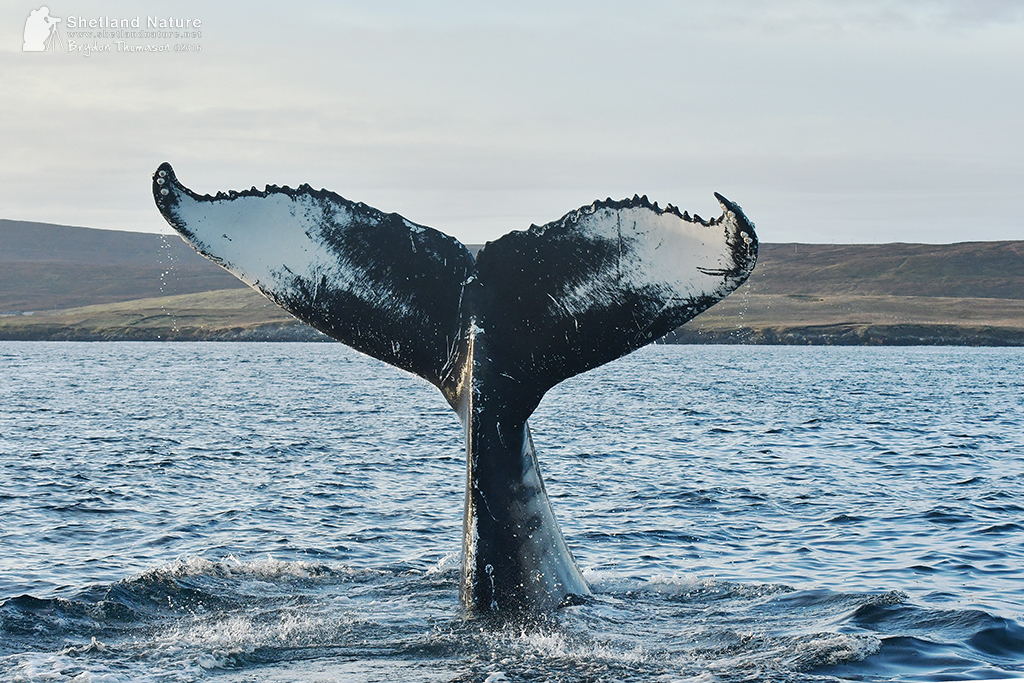
How often do we travel to far flung and exotic locations and continents in search of wildlife? I know this is something I personally used to do and enjoyed immensely. But to see species that otherwise may lure us overseas, right on our home turf takes some beating. If planning a trip for example for the best encounters with Humpback Whales, exotic locations such as Antarctica, Baja Calafornia, Hawaii or closer to home Iceland would all feature on the list but Shetland in mid winter?
This set of images were all taken just last week on the 2nd December off Yell, Shetland. Over the past three weeks there has been up to four Humpbacks inshore between Yell, Fetlar and Unst. They have especially favoured the stretch of water south of Hascosay off Vatster and further south along east side of Yell. We’ve enjoyed sightings of Humpbacks moving north through this area into Bluemull Sound several times now in recent winters, (with mid to late winter appearing to be peak time) but this year they have hung around.
What we were amazed to find on the day we took a boat trip with Peter Hunter out to look for them was that in the area they are favouring most the sea was literally solid with Mackerel shoals, often reading on the sonar down to a depth of 30m, a mass of mackerel from surface to bottom! We could not say however whether they were actually feeding although it looked as though they were. In total we spent about two hours with them before needing to head home as the mid winter sun started to set. I feel really lucky to have seen ‘Humpies’ many times in Shetland and in some truly awesome locations such as Antarctica and Hawaii but this was an encounter I will never forget.
They appeared completely at ease with the boat and our presence, obviously taking a responsible approach we would cut the engine and drift, with them repeatedly working a circuit they’d come right to us, often surfacing as close as 10 metres from the boat, when their blows sprayed our very faces. They passed many times right under us, the ghostly form of the white pectoral fins clearly visible just a few metres bellow.
Seeing any cetacean at close quarters is a true privilege but this day they took the show to another level and really did perform. It was as if they wanted to show us everything they had; spyhopping, pectoral fin and tail surface slapping, the characteristic and iconic tail flukes but the best of all was the positively epic full breach.
I was particularly intrigued by the tail slapping; far from being any sort of cetacean expert I assumed that like Killer Whales, which I often see tail slapping that it would be in some way related to feeding technique or just for fun but it appears it is also thought to be a way of communication. This would make sense as the four whales, paired off in two’s (but seen together on other days) kept quite some distance from each other, usually at least half a mile or more while we were there but always in the vicinity.
It is clear that Humpback whales in British waters is certainly becoming increasingly more regular. Over the past decade sightings have increased particularly off of North East Scotland, western Isles and indeed Northern Isles and we are seeing them annually here. With population recovering well in North Atlantic it is quite probable that occurrences will continue to rise. It is not yet clear however whether British sightings involve western or eastern Atlantic populations although the latter, including Norway and Iceland seems more likely. These areas have seen significant increase in Herring and Mackerel population especially so may tie in with why they are here too. Who knows, perhaps they are now present inshore year round, which would explain the sightings throughout the seasons.
I have sent images for ID purposes to the Sea Watch Foundation and North Norwegian Humpback Whale Catalogue project and very much look forward to see if they come back with any matches…
View Follow-up Post: A Humpback ID match UK first: Caribbean/Shetland Islands
Permalink
Grey Seal pupping season
Posted by Brydon Thomason on Friday 4th January 2013 | Sea Mammals in Shetland
In Shetland Atlantic grey seal pupping season begins in mid to late October through to the end of November; some of the earliest may begin pupping as early as mid-September and exceptionally late individuals may still be in the colonies in early December. Interestingly the colonies on the west side of Shetland begin pupping earlier than the east side ones.
Here they usually choose to give birth on beaches of small ‘geos’ among fairly high remote cliffs or on small offshore islands, meaning that many colonies are often inaccessible without a boat.
Each year I and many other volunteers assist Scottish Natural Heritage in carrying out their annual Grey Seal pupping census around Shetlands many colonies. The variation in habitats here is quite fascinating; in many colonies they give birth at the foot of towering sea cliffs; on pebble and sand beaches, amongst massive boulders and in caves and on grass on low lying offshore islands. This diversity of habitats offers many differing photo opportunities and environments to enjoy them. Unfortunately few of these colonies are exempt from the unforgiving gales that Shetland can experience and the pups are extremely vulnerable in their first few weeks.
There is something very special and exciting about visiting the inaccessible colonies by boat, and to experience the atmosphere these colonies have in late autumn. I often think on them as ‘sea mammal maternity wards’!
Grey seal mothers will nurse the pups for 17-18 days, during which time she remains on the beach and will not feed herself. The pup can gain up to an impressive 2kg of weight per day from her extremely fat-rich milk and is then left to fend for itself, living solely off their blubber reserves. When born, the pups have an absolutely adorable thick, fluffy white coat that takes anything from two to four weeks after weaning, to moult out into their waterproof adult coats. During this time, they cannot swim and are at risk of being swept away by heavy winter seas.
Once taking to the wild and untamed ocean, young seals have been known to wander up to 1,000 km or more from their original place of birth. When pup’s finally take to the ocean they will learn to dives of up to 20 minutes long and to as deep as 300m although the normal depth would be 30-80m. The average life expectancy for a female is about 35 years, males only 25, although the oldest grey seal ever recorded in the world was one in Shetland, a ripe old age of 46!
During the pupping season, the males, which can weigh an impressive 310kg, patrol the colonies keeping a watch on their harem and can go for over six weeks without eating in order to certify the mating with females, which takes place within a day of the females leaving their pups. Amazingly, the females delay their 11 month pregnancy for a month after mating.
The Shetland population is estimated to be around 3,500 which is a fairly healthy population given that the UK population is about 105,000 (nearly 50% of the world total). Although most Shetlanders now know seals to be collectively known as ‘sealkie’, grey seals were once known locally by fishermen as ‘haaf fish’. It’s hard to relate to what the Latin name ‘halichoerus grypus‘, translates as; ‘hooked pig nose of the sea.’
Special care and consideration must be given if visiting colonies as mothers and pups are often very sensitive to disturbance and you should always respect their ‘comfort zone’ and avoid disturbance. Details of this can be found on the SNH website: http://www.snh.gov.uk/news-and-events/press-releases/press-release-details/?id=782
Permalink
Killer Whales and the Mackerel fishing industry in Shetland
Posted by Chris Gomersall on Wednesday 24th October 2012 | Sea Mammals in Shetland
Although Killer Whales cashing in on purse-net fishing by local boats has been known in Shetland waters for some time, in recent years this spectacle has received considerable media coverage, even making it onto national television. To summarise this spectacle, these whales essentially follow the mackerel migration, feasting on them as they go. As the vessels begin to haul their nets the whales tune into the change in revs from the vessels engines and home in to hoover up excess spillage of mackerel from the boats vast nets. SN team member Chris Gomersall shares his account from a recent photographic assignment aboard one of these vessels.
For the third year in a row, I find myself spending much of October in Shetland. And it’s not the rare birds that bring me here, exciting as that might be. What started as a photography assignment for the 2020VISION project has become a bit of a personal obsession, and I still have some unfinished business, in the shape of a massive, black and white torpedo with an over-sized dorsal fin. The killer whale. The trouble is, they don’t always arrive on cue. Or even appear at all.
The logistics of this operation are quite complicated, and entirely beyond my control. To summarise, it involves going out to sea as a guest on a pelagic mackerel trawler. Sometimes (as last year), we end up in Norway, waiting several days for some vital spare part to arrive from Sweden. Usually it’s the fish markets and the global price of mackerel that dictate when the season will commence; weather is very much a secondary consideration. Anyway, after ten days of hanging around, trying not to get impatient and filling my time quite pleasurably visiting old friends in the islands and stalking otters on the shore, my friendly skipper decides the time has come. At this point, I have no idea whether we will be gone for a couple of days or a couple of weeks, but I’ve cleared my diary as best I can and hope for as much sea time as possible. It’s a late night departure, via the fuel berth in Lerwick. Now, for anybody who might be feeling pangs of sympathy for me having to endure a long voyage on a trawler in the North Sea in the autumn, I ought to just point out that I have sailed on far worse cruise ships – these modern 70 metre vessels are not only highly technological they are also very comfortable for the crew, but of course they are still working boats – just very different from the deep sea Grimsby trawlers I remember from my youth. So there’s no need to pity me.
As it turns out, we don’t have to steam very far before we encounter the fish shoals, just outside St Magnus Bay, and as luck would have it it’s a beautifully calm day – which means I can observe from the foredeck. There are fabulous views of Papa Stour, Foula and the Eshaness cliffs in the early morning light, and the slight swell makes for good cetacean-watching conditions. In the distance, somewhere over near Hillswick, I see some wispy splashes that turn out to be dolphins breaching. Only two or three, quite fast-moving, but no discernible features at this range – possibly white-beaked dolphin? Then, just off our bows, a larger whale surfaces briefly: unmistakably a minke. Unfortunately it doesn’t reappear, and another photo opp vanishes with it.
Meanwhile, the fishing is going well, and our first haul of the net brings in a large bag of mackerel, but attracts no orcas. Hours pass, and as the sun lowers I see a tall whale spout against the light in the west. Just the once, and I have little idea what it might be, but presumably a large rorqual of some description. Frustrating, this whale-watching! Our second haul is more productive, from my point of view, and as the nets are being cleaned after all the fish have been pumped aboard, I spot the distinctive dorsal fin of a bull orca, closing in fast. It’s soon clear that he’s not alone, and we have a small pod of about a dozen orca around the boat. By now it’s about 5pm, and the whales stay with us for 20 minutes or so, occasionally spy-hopping for the briefest of moments, and not quite posing long enough for me to train my lens on them. As we trail the net and pick up speed, stray fish fall away and this prompts a bit more activity from the orcas, including some breaching. I photograph what I can, using two camera bodies – one fitted with a 200-400mm zoom lens, the other with a 70-200mm.
Naturally there are more misses than hits. They don’t break surface for long, and usually by the time you’ve found the animal in the viewfinder, pressed the shutter, and the camera mirror has moved out of the way, your subject is back underwater again! So there’s a lot of guesswork, and sighting along the top of the lens trying to anticipate the next leap. And all too soon, the whales peel off and go to look for the next boat that’s got fish. Our crew make another good catch, and unbelievably the fish holds are full within the first 24 hours, so it’s back to Lerwick for us.
It actually takes longer to pipe the fish in to the processing factory than it does to catch them in the first place. There’s nothing left for me to do except book my return trip on the Northlink ferry, and maybe start dreaming about October 2013. Of course I will be back in Shetland before then, joining Brydon Thomason in leading two wildlife photographic workshops in June 2013 – when there’s always the chance of orcas close inshore!
Chris Gomersall
Permalink
A Sperm Whale off Shetland
Posted by Brydon Thomason on Thursday 14th April 2011 | Sea Mammals in Shetland
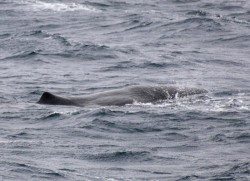
Although behaviourally there is similarity between Sperm and Humpback raising their tail flukes, in appearance they are quite different especially as Sperm lack the prominent white undersides. Their massive bulbous head can measure up to 30% of their overall body length.
On the 7th of April I received a text from David John Anderson, a friend of mine working on board the Skerries ferry, MV Filla. His text described very briefly a large whale which he believed to be a Humpback which they had seen and photographed from the ferry mid-way between the Mull of Eswick and the North mouth of Lerwick Harbour. Needless to say on reading the message I was quick to call him back. His description firstly of the whale lying motionless at the surface quickly urged me to mention Sperm Whale’s characteristic ‘logging’ on the surface. Their views however were leading them much more along the trail of a Humpback and they seemed fairly convinced that that was what it was.
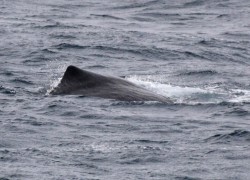
Incredibly Sperm whales have been known to dive to depths of 1000m or more and stay down for over an hour! They have the largest brain of any animal.
Later that evening however DJA downloaded his images and with a brief search of the internet compared them to Sperm and Humpback and tentatively re-identified the whale from his own images. Opening up the images he sent I was green with envy as he was indeed spot on and I have yet to see Sperm Whale in Shetland! As far as records of the species go here they are very much a rare sight inshore. The most recent report inshore off Shetland was back in 2007 when a pod of up to 20 whales were believed to be Sperm whales and before that there were at least 12 off of Noss in 2005. ‘None stranding’ reports or sightings such as these usually refer to pods on their migration. Further offshore they can be seen much more regularly. This sighting most probably involved a male on his Northward migration. The whale was estimated by the ferry crew to be in the region of 40-50 foot in length!
A big thanks and well done to DJA for the haste in getting the news to me and for the use of his images.
Permalink
Killer Whales in Shetland – Sightings, reports and research
Posted by Brydon Thomason on Wednesday 13th April 2011 | Sea Mammals in Shetland
With several sightings of Killer Whales already this spring (leading to some confirmed identification matches) it is indeed very appropriate to bring the work of the North Atlantic Killer Whale ID project to people’s attention again. The continued support both locally within Shetland and indeed from visitors has been key to the success of the project to date. This summer we encourage and invite anyone fortunate enough to see or photograph Killer Whales in Shetland to please contact us to report the sighting. Although co-founder of the NAKID project Dr Andy Foote will be returning to Shetland this summer, he will not actually arrive until the 3rd of July when he will be joining us on our North Isles Nature Cruise with Simon King. Once again we are delighted to have Andy on board as sea mammal specialist and he is looking forward to sharing information, aims and indeed the progress of the Killer Whale ID project to date.
“In the absence of any of the research team for the first part of the 2011 spring/summer we are asking for reports and information on Killer Whale sightings to please be called or texted in to Brydon on 07786982773. Brydon has played an integral role in the project from the start and has been helping us both when we are there or away, so it seems like a natural transition and the best way for us to keep information and interest going within the isles. We also hope to make the ID catalogue available to the public as a free download at some point this summer.” Dr Andy Foote, NAKID
Dr Volker Deeke (a research fellow at the Sea Mammal Research Unit studying the behaviour of killer whales in Scottish waters) also hopes to be rejoining the Shetland Nature team this summer.
For an update of 2010 Killer Whale sightings visit www.shetlandnature.net/2010/12/02/killer-whale-sightings-in-shetland-2010/
And for more information on the NAKID visit www.northatlantickillerwhales.com
If you would like to find out about where and when in Shetland Killer Whales are seen this is also a good opportunity for wildlife enthusiasts throughout the Isles and indeed visitors to Shetland to consider following Shetland Nature on Twitter and Facebook. We have been using to filter news and reports of Killer Whale sightings as and when they happen, leading to more and more people enjoying encounters. Especially given our working relationship with the research team and acting as their point of contact for sightings and reports in Shetland this offers the most informed and up to date insight into Killer Whales around Shetland.
You can can follow our Twitter stream at twitter.com/shetlandnature
If you are a Facebook user you can join our page at www.facebook.com/shetlandnature
It’s not only Killer Whale sightings that you will be able to follow in this way but also all other wild and wonderful sightings, such as other exciting sea mammals and rare birds, which come via the local birding grapevine or straight from the scene as it happens!
Permalink
Bearded Seal in Baltasound
Posted by Brydon Thomason on Wednesday 6th April 2011 | Sea Mammals in Shetland
Only a year since Shetland’s last visit from this majestic Arctic sea mammal (read our news post on last year’s Bearded Seal), this beautiful beast was discovered in Baltasound on Unst. It was only minutes after finishing our dinner that a rather excited Desley Ritch appeared at our door and proceeded to thrust her camera’s LCD screen towards my face, in a sort of ‘see what I’ve seen’ sort of way. “Is this something different?” She asked in a cheerfully sarcastic tone, “Blimey- its a Bearded Seal!” I exclaimed, as she went on to say that they, her and her brother Christopher (who had found it earlier in the afternoon) were quite sure that that’s what it was.
Desley had hardly begun explaining where it was and my jacket was on and boots were being laced up. Thankfully it was just a few minutes along the road right slap bang in the middle of a reasonably busy little marina where it lay hauled out on the slip way. Whilst my wife Vaila got ready to join me I quickly rang the news around – desperate to get down there before the light went all together, it was already after six!
Thankfully, we managed to get news around every one locally and within minutes we were all stood barely a few meters away from a Bearded Seal, all the way from the Arctic! Unfortunately the seal proved not to be as long a stayer as last year’s individual, which was only the 12th record for Shetland and only lingered for another two days. A voicemail that eventually found its way through to my mobile later that evening was from Christopher earlier in the afternoon with the news – while I was out on a boat photographing a King Eider, yip that’s Shetland for you, a naturalist’s paradise!
Permalink


